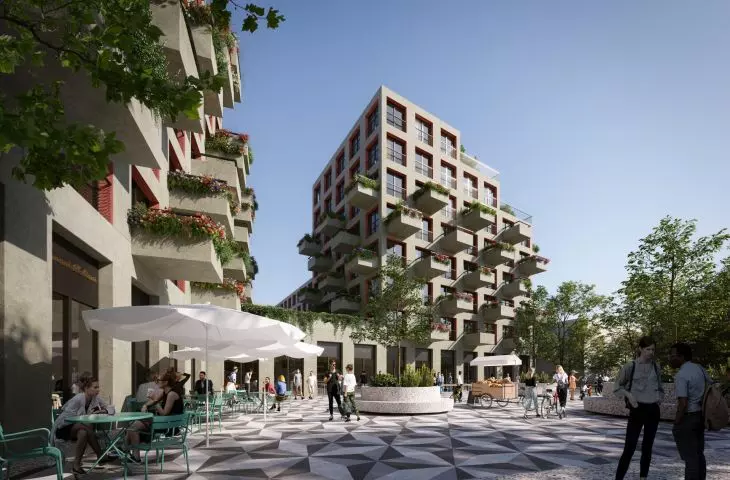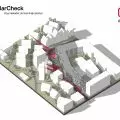The "tin ware houses" - decapitated shopping centers of the so-called first generation - are beginning to disappear from the space of Polish cities. This includes the case of some Tesco markets, which will be replaced by residential developments. In Lodz, the Zenit housing development will be built on Widzewska Street, and work is underway on a concept for the site at Kapelanka in Krakow. In Poznań, meanwhile, the investor is currently consulting on its plans in the Piątkowo district.
The demands of Poznan city planners and architects from more than two decades ago are beginning to come true. In the 1990s, valuable areas in modernist residential districts from the communist era were developed with simple grocery and construction markets. The one-story halls bore little resemblance to the ambitious retail and service complexes that had previously been planned to be erected on area reserves, a fact that local planners and some councilors had already commented critically on at the time. They urged that the "tin warehouses" be removed from the city as soon as possible.
Shopping center on Opieńskiego Street in Poznań (former Tesco)
- View from the intersection of Opieńskiego and Szeligowskiego streets
Photo: Jakub Glaz
Now, after nearly a quarter of a century, a former Tesco store with a shopping arcade and extensive parking lots on Opieńskiego Street is to disappear from Poznan's Piątkowo district. It occupies four and a half hectares in the southwest corner of the newer, post-1990 development part of the Batory neighborhood. The area is located next to a stop of the Poznan Fast Tram - the transportation spine of the northern part of the city. The sprawling, low and decapitated complex is an architectural and urban sub-standard - with a large parking lot on the side of Opieńskiego Street and a chaotic hinterland adjacent to the estate's blocks.
northern dominant
The land after the decommissioned Tesco was bought by developer Echo Investment, the same one that invests in the former Tesco sites in Lodz and Krakow and intends to transform part of Warsaw's "Mordor," an office complex in Sluzewiec, in the coming years. At Opieńskiego Street in Poznań it plans to build a complex of residential buildings with services and retail on the first floor . However, a local zoning plan has not been passed for the area where he wants to carry out the investment. Neighborhood and city councilors (from the Wspólny Poznañ club) are calling for work on the plan to begin. The problem is that on the former Tesco site the current study of land use conditions and directions envisages a service function. Admittedly, the study is in the process of being amended, but the investor is anxious for time. He therefore intends to apply for a zoning decision, and the city - clearly favoring these intentions - is not calling up the plan.
Visualization of the development on Opieńskiego Street in Poznan on the site after the shopping center
- square at the exit of the fast streetcar stop, left: the tallest building of the development
© Echo Investment
What is the new development supposed to look like according to the concept developed by theinvestor's internal design team led by Krzysztof Giemza? The appearance of the northern part of Piatkow may change dramatically thanks to the corner seventeen-story dominant building, which is a strong accent in the space of the thoroughfare running parallel to the tramway. Next to it, three slightly lower and massive buildings can stand. Between them and the housing development - eight three-story blocks. They are to be separated from the older buildings by a green belt (also penetrating the space between the buildings), called a park by the investor. The tall buildings are to shield the estate from the noise coming from the vast intersection and from the side of the high-speed streetcar, while the low buildings are to harmonize with the existing scale of the estate. All buildings are to accommodate about 900 apartments.
Visualization of the development on Opieńskiego Street in Poznań on the site after the shopping center
- The space between the low-rise blocks of the northern part of the complex
© Echo Investment
The entire site is envisioned as a public area. Unlike the former Tesco, which is a functional barrier - it is intended to allow better access from the development to the fast streetcar. Along the way, residents will be able to take advantage of the stores and services on the first floors of the taller buildings. Between them, the designers propose three squares, and the concept also shows an "urban square." Its location, however, seems somewhat problematic, as it is located not in the central part of the complex at the access to the fast streetcar, but on the eastern outskirts of the premise.
research will come in handy
The concept is not final, however. Weronika Ukleja, spokesperson for Echo Investment, confirms our information that the project is currently being detailed at the Sopot-based Maarte studio. Before applying for development conditions, the investor is now presenting its intentions to residents and highlighting the assets of the investment. With the help of hired companies, he is conducting quite detailed consultations, details of which can be found on the copotesco.pl website. Surveys are being conducted not only online, but also in the space of the estate and the neighborhood. On the first Saturday of September, pollsters waited for residents within the still operating complex that housed the market. So far, opinions seem to be divided, with some residents happy about the removal of the ugly "tin", while others are worried about the change in the status quo. Apparently, only representatives of Poznań Housing Cooperative are protesting, who do not like the height of the building and the change in the function of the area.
The junction of the only major green area in the Batory estate and the development bordering the shopping center on Opieńskiego Street
photo: Jakub Głaz
An increase in the number of residents and, consequently,an increased traffic load on the district, both on streets and parking lots, as well as on public transportation, could also be a problem. Already, during rush hour, carts on the rapid streetcar route are running at overbooked capacity. Regardless of surveys and in-depth interviews, it therefore seems necessary to conduct expert analyses of the impact of the development on the neighborhood's traffic system, the load on nearby schools and kindergartens, and parking lots. Such studies will help answer whether the development - somewhat too intensive at first glance - should be built as it is.
The problem here seems to be not so much the height of the dominant building (about 55 meters), which will favorably affect the amorphous space of the intersection and view axes, but the target number of apartments and the ratio between the development and open areas. Admittedly, the residential developments of recent decades also do not sin with an excess of open space, but this is no reason to continue this mistake. It is also necessary to keep a close eye on the target quality of the architecture to match the level of what can be seen now in preliminary visualizations.









































